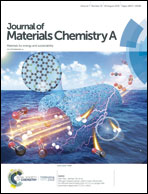Wide potential and high energy density for an asymmetric aqueous supercapacitor†
Abstract
Although an asymmetric aqueous supercapacitor is a promising energy storage device because of its high specific capacitance and enhanced safety, its potential window is still limited by the intrinsic electrochemical stability of water, which impedes further improvement in energy density (E = 0.5CV2). Here, Na+ was adsorbed onto a graphene aerogel negative electrode via the electroreduction technique, which effectively prevented the intermediate hydrogen evolution reaction product formation and increased the working potential. Interestingly, we found that the potential of the negative electrode could be extended to 1.4 V (vs. SCE) with significantly increased specific capacitance of up to 285 F g−1. To complement this wide-potential negative electrode, C@Mn3O4 was employed as the positive electrode to construct an asymmetric aqueous supercapacitor. Interestingly, the as-fabricated aqueous asymmetric supercapacitor exhibited a working potential of 2.7 V with high energy density of 110.4 Wh kg−1 and power density of ∼1.352 kW kg−1 as well as an excellent cycle performance, outperforming previously reported asymmetric aqueous supercapacitors. This work provides new opportunities for developing a wide-potential asymmetric aqueous supercapacitor with high energy density and high power density.



 Please wait while we load your content...
Please wait while we load your content...